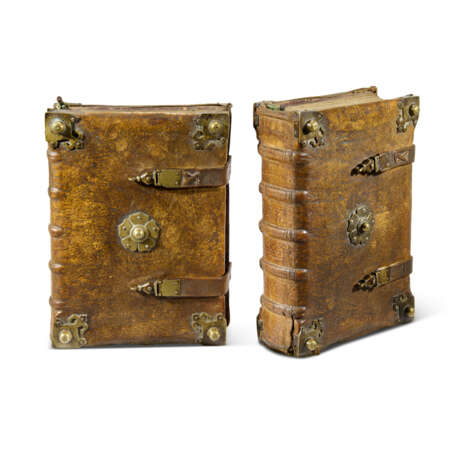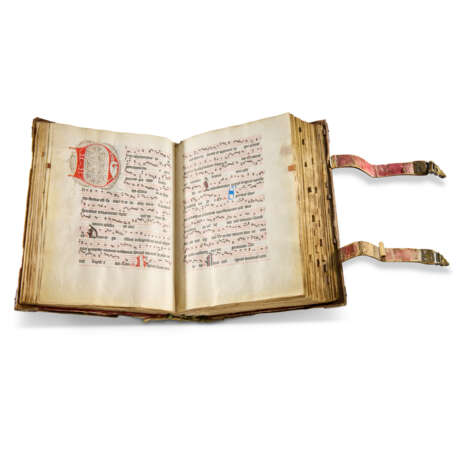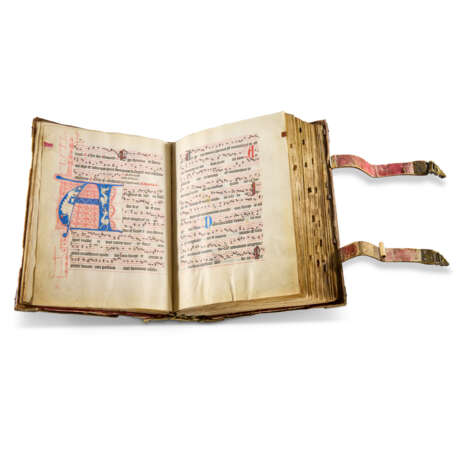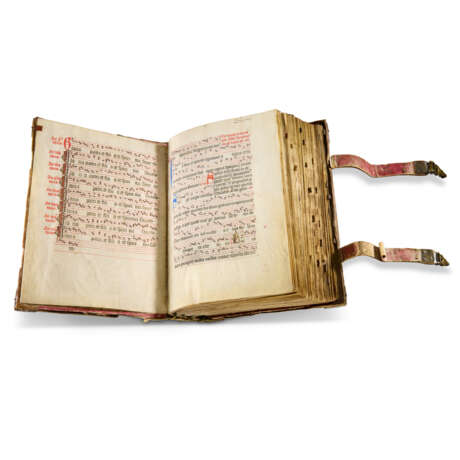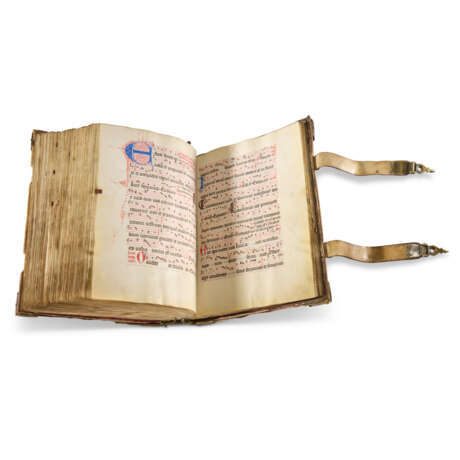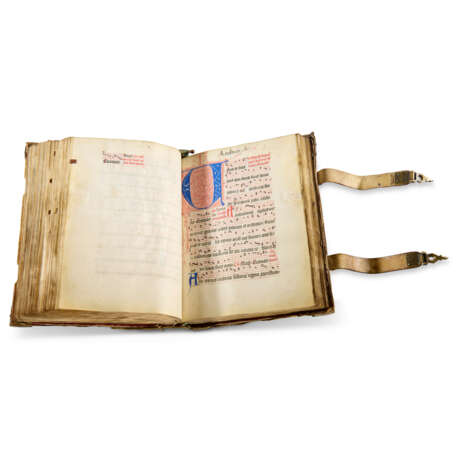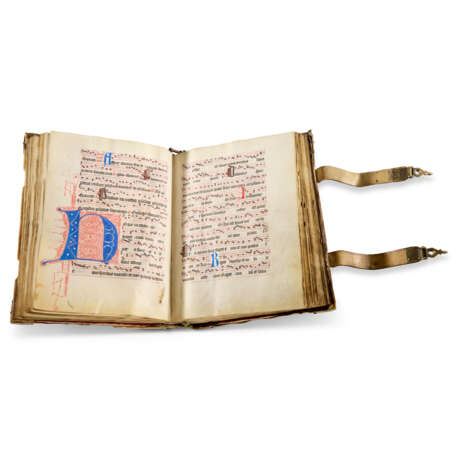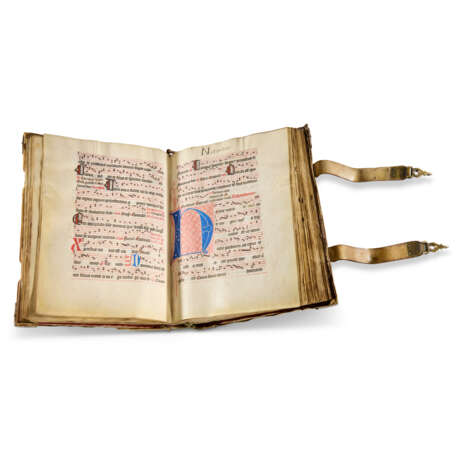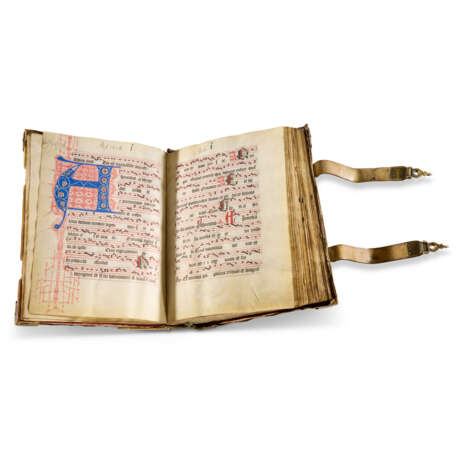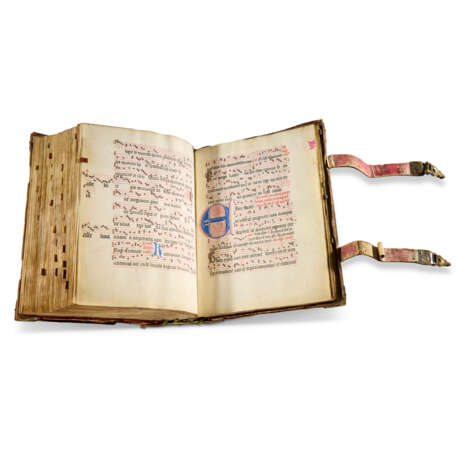ID 1214873
Lot 34 | A Franciscan Antiphonal
Estimate value
£ 60 000 – 90 000
Antiphonal for Franciscan use, in Latin with scribal notes in German, decorated manuscript in two volumes on vellum [Germany (Bamberg?), 1430]
An extremely handsome matching pair of volumes of Dominican chant, with notes concerning their manufacture and cost, in contemporary bindings in fine condition with very rare bar bookmarkers.
325 × 235mm. 262 and 260 leaves, complete, collation, vol. I: 110 (i is the pastedown), 26 (of 8, last two blanks cancelled), 3–338, vol. II: 19 (of 8, i inserted), 2–118, 127 (of 8, last blank cancelled), 13–318, 329 (of 8, ix inserted), catchwords throughout, quire signatures starting from the third gathering in each volume in arabic numerals, many gatherings also marked ‘cor(rectum)’, 10 lines of text and music per page: 230 × 160mm, decorated with 18 large initials in blue with red penwork (occasionally vice versa), and 4 very large initials in blue sometimes with with reserved designs of hybrid creatures, a flowers, fruit, foliage, with dense penwork in red (that in vol. II, f.43v, in red, with a winged stag design, and brownish penwork), sometimes with human heads etc. (post-medieval notes in margins and on endleaves)
Binding:
In matching contemporary bindings sewn on five bands laced into thick wood boards covered with undecorated pigskin, with large bosses at the corners and in the centre and two strap-and-pin fastenings (attaching from the back board to the front), their undersides showing that the skin was originally red (the joints with some cracking, but still apparently very strong and sturdy), with linen place-markers, tied at the head to a wood bar (Swales and Blatt, 2007, knew of only 10 pre-1500 examples including the present two).
Provenance:
(1) Written in 1430, perhaps for a Dominican house at Bamberg, northern Bavaria: each volume begins with a formally written note in German recording the date and price: ‘Item das puch ward geschriben und bezalt von des pecherers [vol. II: becherers] gelt das er zu den puchern geschikt hot noch Cristi gepurt Mcccc und in dem xxx ior und kost xxiiij guldern und lv pfennig [vol. II: xxiij guldem und Ixxj pfennig]’. In the Common of saints, ‘In festo beate Kunegundis’ or ‘In festo beate Kunegundis cantetur sic’ is written in red, twice in each volume, next to the chant for a virgin (vol. I, ff.249v and 151; vol. II, ff.243v and 245), strongly suggesting a connection with Bamberg, whose cathedral Kunigunda co-founded and funded. There was from the 14th century a Dominican monastery and convent of nuns in the city; the present manuscript may have been made for one of these.
(2) Lucy Ann Pease (1844–1910/11), with her bookplate including her arms and motto ‘Pax et spes’; by descent to:
(3) Christopher Henry Beaumont Pease (1924–2005), second Baron Wardington, politician and book collector: with his gilt bookplate with his monogram and the Pease motto; sold as the property of his children, Lucy, Helen, and William Pease, at Christie’s, 7 December 1998, lot 28 (with col. and b&w ills.).
(4) The Schøyen Collection, MS 198.
Content:
Vol. I (Winter part): Dominican Tonary: ‘Omnis cantus ecclesiasticus in mediis clavibus terminatur hoc est in d. e. f. g. gravibus […]’, f.1v, followed by the eight tones, with music, ‘De primo tono. Primus tonus sic incipit et sic flectitur […]’, f.2, and versicles, hymns, etc., for various hours and days; chant for the feast of the Conception; ruled with staves, otherwise blank, f.14v; Temporale: from the first Sunday in Advent, f.15; Sanctorale, f.147, from Andrew, including the Translation of Thomas Aquinas, f.197v, and his main feast, f.216; Common of Saints, f.227v; the back pastedown is most of a bifolium of a 14th-century copy of Ps-Aristotle, De proprietatibus elementorum.
Vol. II (Summer part): Eight versions of the Gloria, for the different tones, f.1v; chant for the feast of the lance and nails of the Crucifixion, f.2; chant for the Presentation, f.7, followed by hymns, with different versions for different grades of feast; Temporale, f.18, from the vigil of Easter, including the Dedication of a church, f.92v; Common of Saints during Eastertide, f.99; Sanctorale, f.102, including Peter Martyr, f.102, the Translation of Dominic, f.111, Dominic, f.146v; Office of the Dead, f.193v; Common of Saints, f.221; the back pastedown is a leaf from a large 14th-century alphabetical index, Caritas–Conversionis, each entry with a folio number and section-letter(?) A–Q.
Decoration:
The largest initials are for the feasts of (vol. I) Advent, f.15v, Christmas, f.44, and Epiphany, f.55v, Andrew, f.147; and (vol. II) Presentation, f.7v, Easter, f.18v, Pentecost, f.43v, Trinity Sunday, f.51, Sunday after Trinity, f.62.
Literature
Swales, L. and H. Blatt, ‘Tiny Textiles Hidden in Books: Toward a Categorization of Multiple-Strand Bookmarkers’, Medieval Clothing and Textiles, III, 2007, pp.149, 177-78.
| Place of origin: | Western Europe, Germany, Europe |
|---|---|
| Auction house category: | Medieval & renaissance manuscripts, Books and manuscripts |
| Place of origin: | Western Europe, Germany, Europe |
|---|---|
| Auction house category: | Medieval & renaissance manuscripts, Books and manuscripts |
| Address of auction |
CHRISTIE'S 8 King Street, St. James's SW1Y 6QT London United Kingdom | |
|---|---|---|
| Preview |
| |
| Phone | +44 (0)20 7839 9060 | |
| Buyer Premium | see on Website | |
| Conditions of purchase | Conditions of purchase |
